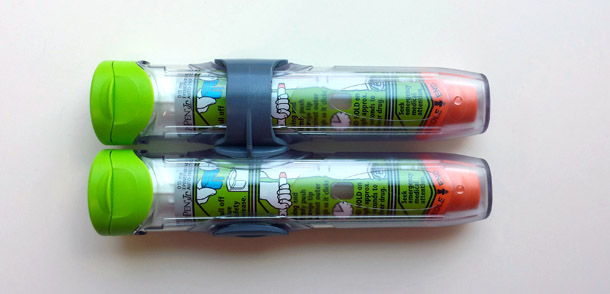A recent CNN news story sent shock waves through me. As a mother of a child with multiple food allergies, including nuts, I’ve always been mentally reassured by his epinephrine pen. Wherever we go, whatever restaurant we eat at, I know that if my questioning and due diligence of food allergens on the menu fails, I will always have his epinephrine injection as a back-up. It’s our fail safe.
After reading this story about a girl who died after receiving multiple epinephrine injections, I feel deflated. How can I keep my son safe? Aside from only allowing him to eat food I prepare for him? This obviously isn’t practical, nor do I want him to live that kind of sheltered life. Fortunately, I work at a place that allows me to get answers to my questions quickly.
So I thought I would share my findings with my fellow food allergy parents out there, who likely had the same reaction I did upon reading that tragic story. The bottom line is, according to Dr. Amal Assa’ad, director of clinical services in Allergy & Immunology, if the epinephrine injection is used properly, it is 100% effective. It’s just the rare stories like Natalie’s that make us all anxious. Dr. Assa’ad offered the following guidelines to ensure that your child’s epinephrine injection is as effective as possible, and to refresh your memory on what to do if he or she does have an anaphylactic reaction:
- Make sure the epinephrine injection is up-to-date. An expired epinephrine injection is not as effective. And if your child has changed weight in the last year, be sure to see your doctor for a new prescription. Dosage is based on weight, and if an insufficient dose is given, it may not be as effective.
- If you are sure that your child has eaten a nut and starts having symptoms, administer the epinephrine injection IMMEDIATELY. Using it at the start of a life-threatening allergic reaction may prevent the reaction from becoming worse.
- Call 911 immediately. The emergency responders will secure your child’s airway and start an IV to pump fluids. Too much epinephrine without adequate blood volume in the blood vessels has the same adverse outcome as no epinephrine.
- Keep the double pack of epinephrine injections together. Up to 40% of people need more than one dose of epinephrine during anaphylaxis. The first dose of epinephrine can wear off before the emergency responders get there, so don’t split them up.
- Stay calm and reassure your child. Kids look to their parents to determine how to respond to a situation; if we stay calm, they’re more likely to stay calm.
The good news is there may be hope on the horizon for parents of kids with peanut allergies. Dr. Assa’ad is a part of a multi-center research study to test the effectiveness of a patch that desensitizes people who are allergic to peanuts. It’s a similar concept to allergy shots. The patch contains a minuscule amount of peanut allergen, which seeps into the skin without causing an allergic reaction. Hence, the body gets used to this small amount of peanut allergen and the body begins to not react to it when it sees it in larger quantities. The study has completed enrollment and may have results in one to two years.
Until then, we’ll continue to be armed with injectable epinephrine.






Very helpful post!